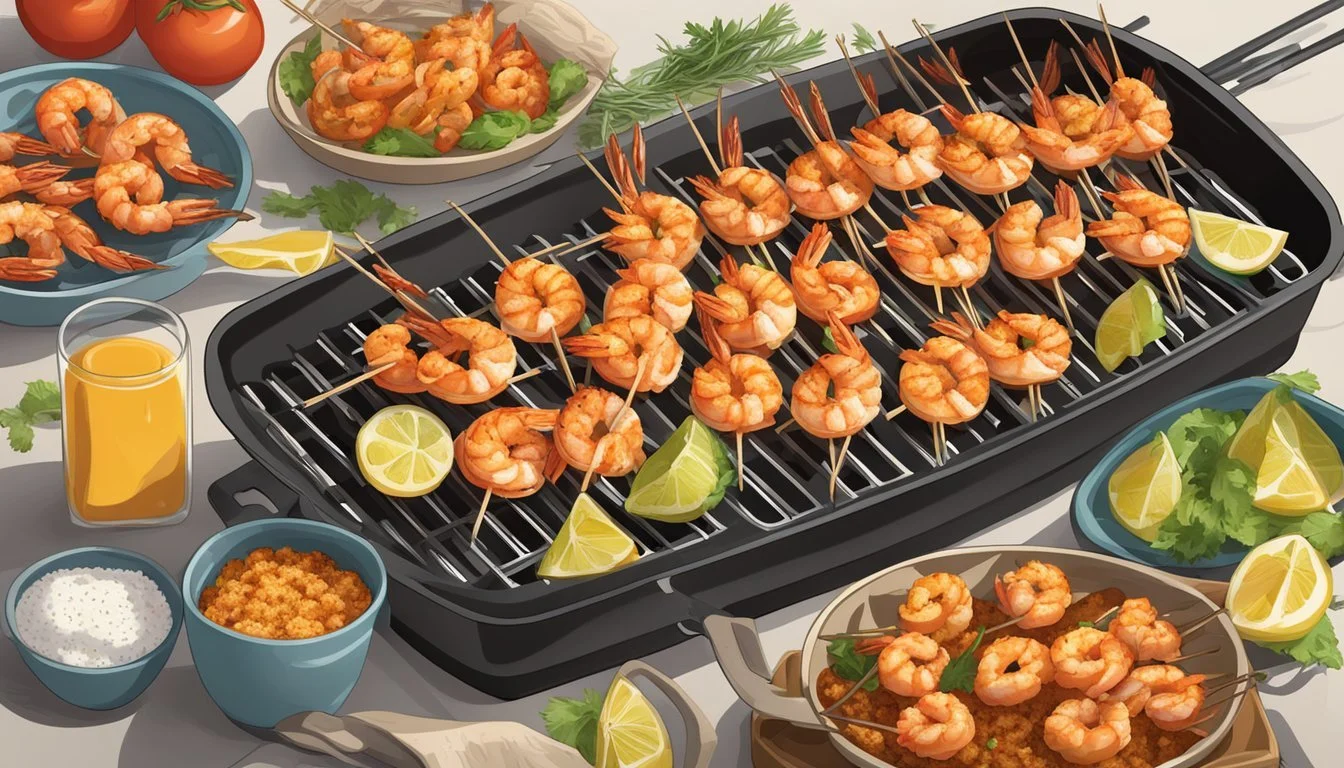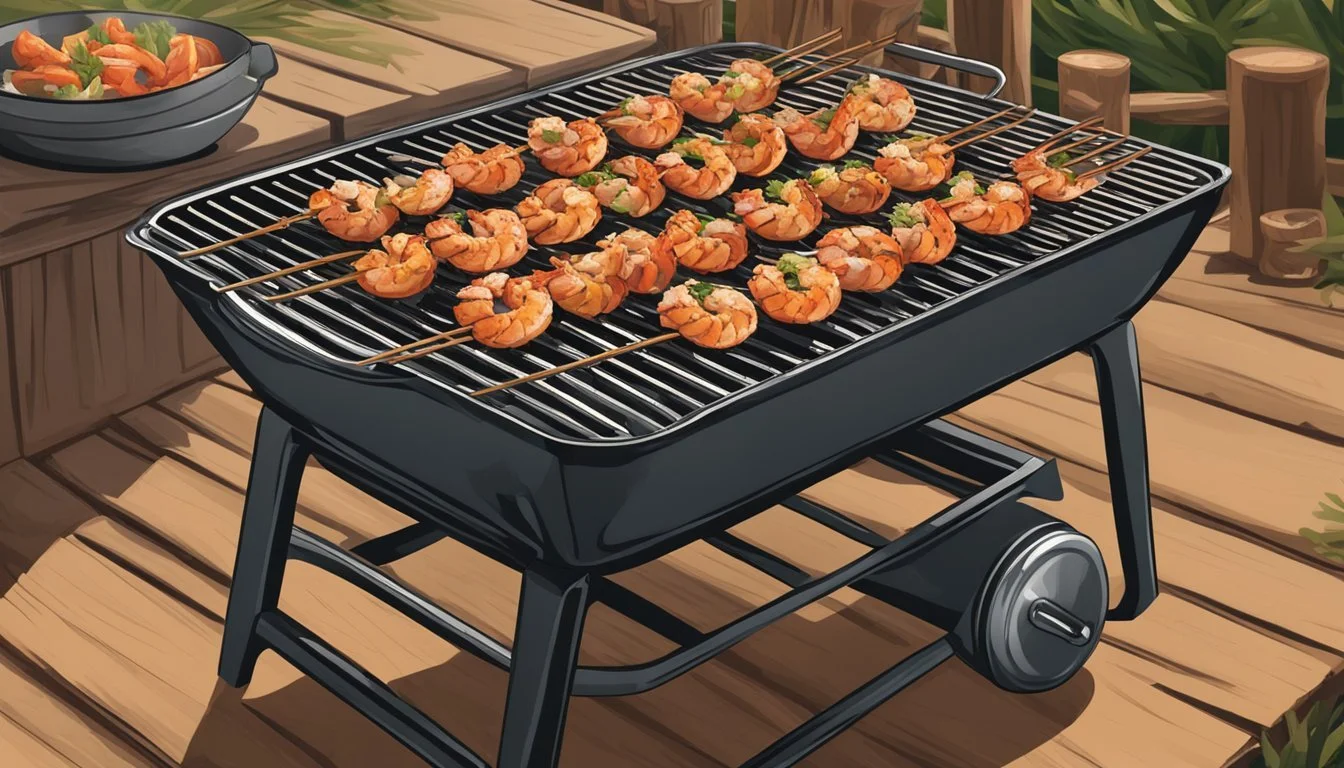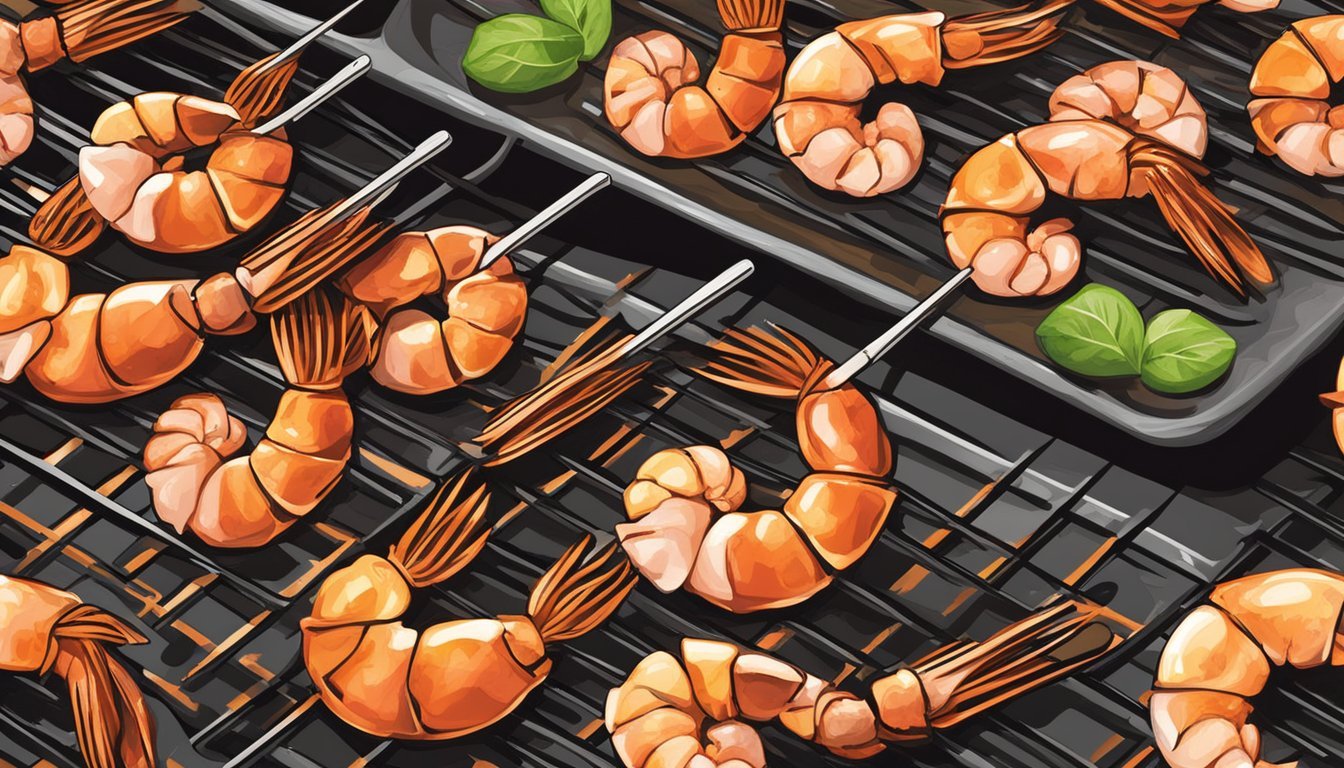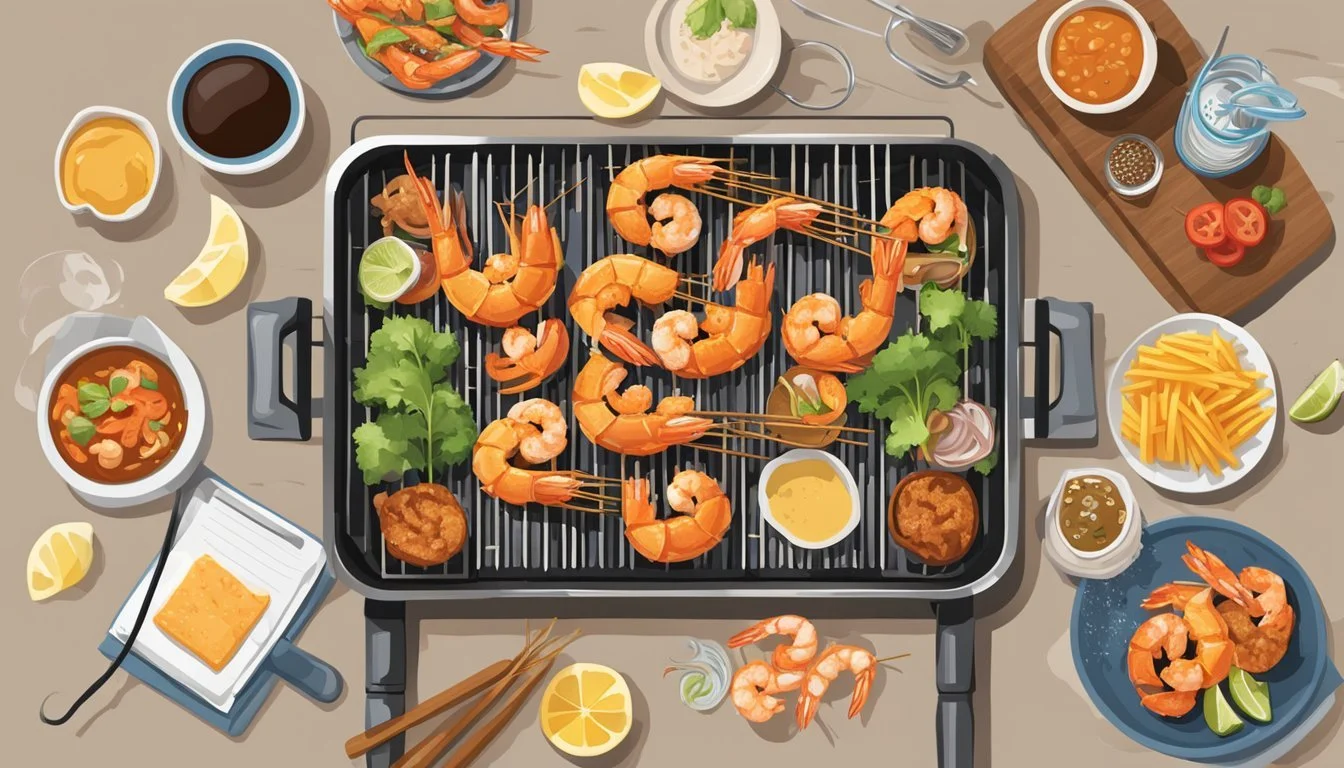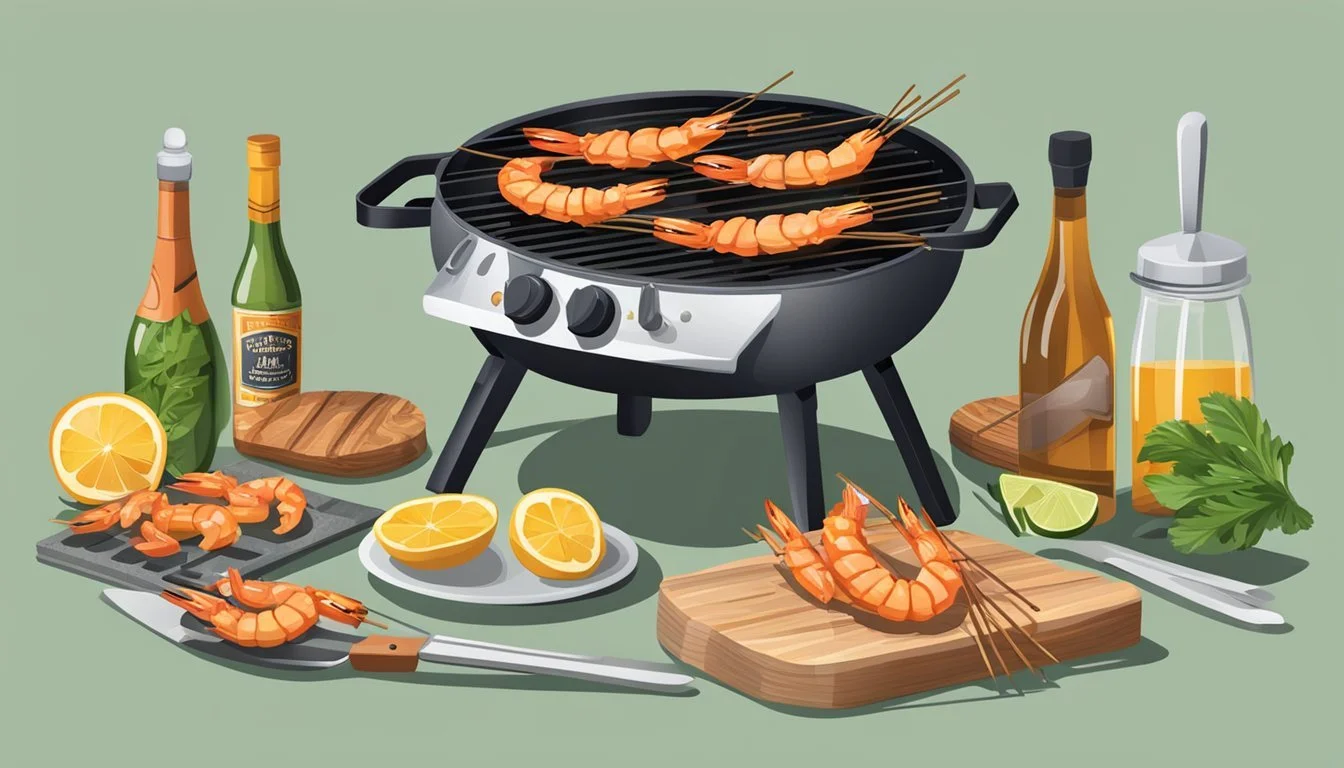How to Grill Texas-Style Shrimp Skewers
A Step-by-Step Guide
Grilling shrimp (What wine goes well with shrimp?) skewers is a culinary art that showcases the simplicity and appeal of combining shellfish with the smoky char of a grill. The coastal flavors of shrimp are brought to life through high heat and the right blend of seasoning, resulting in a Texas-style delicacy that's as bold as it is straightforward. Cooking this Southern favorite involves marinating the shrimp in a concoction of spices and herbs, ensuring each piece is infused with flavor before hitting the heat.
In Texas, grilling is more than a method of cooking; it's a tradition that speaks to the larger-than-life attitude of the region. The key to perfectly grilled shrimp skewers (What wine goes well with grilled shrimp skewers?) lies in the balance of marinade and grilling technique, imparting a zest that's unmistakably Texan. As these skewers are laid out over the grill, the marinade caramelizes under the fiery temperature, sealing in the juices and creating a lightly crispy exterior.
Choosing the Right Shrimp
Selecting the proper shrimp is the foundation of a successful grilled shrimp skewer dish. Optimal freshness and preparation are critical for a tasty outcome.
Selecting Fresh Shrimp
When choosing shrimp for your skewers, one should prioritize freshness. For the best quality, here are specific pointers:
Size: Aim for large or jumbo shrimp, as they are easier to skewer and grill.
Appearance: Shrimp should exhibit a translucent look with a slight sheen, indicating freshness.
Smell: Fresh shrimp have a salty ocean scent; any hint of ammonia suggests they are past their prime.
Sources: Look for reputable suppliers, prioritizing those who offer sustainably sourced shrimp.
Preparing Shrimp for Grilling
Before grilling, proper preparation ensures quick and even cooking:
Deveining: Make a shallow cut along the back and remove the dark vein.
Tails On or Off: Keeping tails on adds visual appeal and can provide a handle for eating, but removing them is acceptable for a more fork-friendly experience.
Skewering: Use bamboo or metal skewers; threading 5 to 6 shrimp per skewer with slight space between them promotes even grilling.
Simple Marinade: A mix of olive oil, lemon juice, and a few chosen spices can enhance the shrimp's natural flavor. Marinate for 20 to 30 minutes for optimal taste.
By carefully selecting and preparing shrimp, they will deliver a delectable taste when grilled on skewers, making them the highlight of any shrimp recipe.
Essential Grilling Tools
For successful Texas-style shrimp skewers, one needs the right tools. Precision and appropriate equipment ensure a flavorful, well-cooked result that brings out the Texas charm in every bite.
Types of Skewers
Metal Skewers: These are ideal for grilling because they are sturdy and can handle the heat without burning, unlike wooden skewers. There are flat and round varieties, but flat skewers prevent the shrimp from spinning when flipping them on the grill.
Flat Metal Skewers: Ensures even cooking of the shrimp.
Round Metal Skewers: Might allow shrimp to spin, making them harder to manage on the grill.
One should see to it that the skewers are long enough to extend across the grill grate and hold an adequate number of shrimp.
Grill Setup
The type of grill used affects the flavor and cooking style of the shrimp skewers.
Grill Grate: A clean grate prevents shrimp from sticking and ensures beautiful grill marks. It's essential for any barbecue grill setup.
Fire Source:
Propane Grill: It provides consistent heat and is easy to control, which is essential for grilling delicate proteins like shrimp.
BBQ Grill: Can refer to either charcoal or gas grills, but for Texas-style, many prefer the smoky flavor that charcoal grills impart.
The grill should be preheated to a medium-high temperature, which allows for a quick sear while keeping the shrimp juicy. The grill grate should be as close to the fire source as is suitable for the size of the shrimp to ensure proper cooking.
Texas-Style Marinade and Seasonings
The success of Texas-style shrimp skewers hinges on its zesty marinade and robust seasoning mixture. These combine classic spices and fresh ingredients to ensure every bite is infused with flavor.
Creating the Marinade
To create the marinade, one starts with a base of olive oil, which not only adds a rich texture but also serves as a carrier for the other flavors. Fresh lemon juice is incorporated for its acidic brightness, tenderizing the shrimp and enhancing their taste. Specific measurements include:
Olive oil: 1/4 cup
Lemon juice: 2 tablespoons
Into this base, a blend of freshly minced garlic and a selection of herbs such as oregano is stirred in. Minced garlic imparts a warm, aromatic quality to the shrimp, while herbs like oregano contribute a slightly earthy and peppery note, integral to the Texas-style profile. These herbs can be tailored to preference, with basil being a suitable addition for those who enjoy a sweet, peppery undertone.
Seasoning Mixture
The seasoning mixture is crucial in defining the Texas-style flavor. It starts with kosher salt, which has larger grains than regular table salt and provides a more controlled seasoning. Black pepper adds a sharp heat that complements the subtle sweetness of the shrimp. The standard ingredients for the seasoning mixture include:
Kosher salt: 1 teaspoon
Black pepper: 1/2 teaspoon
To this foundation, one adds paprika for color and a gentle warmth. For those desiring a bit of Texan heat, a pinch of cayenne pepper can be introduced. This spice is potent, so it should be used sparingly. This combination of seasonings should be whisked together thoroughly before coating the shrimp to ensure an even distribution of flavors.
Grilling Procedure
Grilling Texas-Style Shrimp Skewers involves a robust flavor infusion through marinating and precision cooking on a grill. The succulent shrimp are cooked to perfection when the proper techniques are employed.
Marinating the Shrimp
Prep Time: 15-20 minutes
Marinate Time: 30 minutes
To start, one must marinate the shrimp, which imbues them with the bold flavors synonymous with Texas cuisine. A chili lime rub forms the cornerstone of the flavor profile:
Begin by peeling and deveining the shrimp.
Prepare the marinade by mixing olive oil, fresh lime juice, minced garlic, chili powder, and other spices of choice in a large bowl.
Submerge the shrimp in the marinade ensuring each piece is well-coated.
Cover the bowl and refrigerate for 30 minutes, which allows the flavors to penetrate deeply.
Grilling the Skewers
Cook Time: 5-7 minutes
Total Time: Around 45-55 minutes including marinating and prep
Once marinated, it's time to grill the skewers:
Preheat the grill to medium-high heat (around 375 to 450 degrees Fahrenheit).
Thread the marinated shrimp onto skewers. If using wooden skewers, soak them in water for at least 20 minutes beforehand to prevent burning.
Place the skewers on the grill grates and cook for 2-3 minutes on each side or until the shrimp reach an internal temperature of 145 degrees Fahrenheit. Shrimp are cooked through when they are pink and opaque.
The shrimp should exhibit a light char and the intoxicating aroma of the chili lime rub.
Following these specific steps ensures grilled shrimp that are bursting with Texas-style flavor, possessing the perfect balance of smoky and spicy with a hint of citrus zest.
Serving Texas-Style Shrimp Skewers
When serving Texas-style shrimp skewers, the richness of flavors and the vibrant colors of the dish are accentuated by thoughtful accompaniments and presentation.
Accompaniments
Texas-style shrimp skewers pair well with a variety of sides that complement their bold taste and add to the overall experience. Here are some accompaniment suggestions:
Rice: A simple bed of rice provides a neutral base that absorbs the shrimp's juicy flavors.
Veggies: Grilled vegetables (What wine goes well with grilled vegetables?) like bell peppers or zucchini add a slight char and a healthy balance to the plate.
Barbecue Sauce: Offering a small bowl of barbecue sauce adds a smoky, sweet touch that Texans adore.
Melted Butter: A dish of melted butter for dipping accentuates the shrimp's succulent flavor.
Presentation
The visual appeal of Texas-style shrimp skewers can be as impressive as their taste. Here are some tips for presentation:
Have the shrimp arranged neatly on the skewers with tails pointing in one direction for uniformity.
To enhance color, garnish with a sprinkle of fresh parsley over the shrimp and sides.
If serving as an appetizer, the skewers can be presented on a platter with lemon wedges for squeezing extra flavor onto the shrimp.
Bold and full-flavored, these skewers can stand as the star of a meal or as a crowd-pleasing starter.
Nutritional Information
When preparing Texas-style grilled shrimp skewers, the nutritional content can vary depending on the specific ingredients used and the serving size. Typically, such a dish may be characterized by a balance of protein, fats, and a small amount of carbohydrates.
A standard serving of grilled shrimp skewers may contain approximately:
Calories: 200-250
Protein: 24g
Total Fat: 10g
Saturated Fat: 1.5g
Unsaturated Fat: 7g
Carbohydrates: 5g
Sugars: 1g
Fiber: 1g
Cholesterol: 180mg
Sodium: 400mg
These values can be broken into more specific nutritional components:
Vitamins: Shrimp skewers provide a good source of certain vitamins like vitamin B12 and niacin.
Minerals: They're high in essential minerals such as iodine, phosphorus, and selenium.
It is important to note that while the shrimp themselves are low in fat and carbohydrates, the marinade and additional ingredients can increase these amounts. To illustrate, using olive oil adds healthy fats, while certain seasonings may contribute to the sodium content.
For those managing dietary restrictions or conditions like hypertension, it is advisable to moderate the sodium levels by adjusting the seasoning to taste. Furthermore, those following a ketogenic or low-carbohydrate diet might find grilled shrimp skewers a fitting choice, provided sugar-based ingredients are avoided in the preparation.
Grilled shrimp skewers can thus offer a flavorful, nutritious option that fits within a variety of dietary needs when prepared with consideration to ingredient quality and quantity.
Additional Shrimp Grill Recipes
Exploring different shrimp grill recipes can elevate a simple skewer to a celebration of flavors. Here are some enticing ways chefs may reinvent grilled shrimp skewers.
Variations of Shrimp Skewers
Citrus Herb Shrimp Skewers: Grilled shrimp marinated in a mixture of fresh herbs such as parsley, dill, and chives, alongside a zesty lemon or lime juice.
Spicy Grilled Shrimp: A spicy dry rub combining cayenne pepper, paprika, and garlic powder can give shrimp skewers a fiery twist.
Cajun Shrimp Skewers: Infuse skewers with a Cajun seasoning blend featuring oregano, thyme, and a pinch of cayenne pepper for that Louisiana flair.
Blackened Grilled Shrimp Skewers: Coating shrimp with a robust blackening seasoning before grilling can achieve a charred, smoky crust without overpowering the shrimp’s natural sweetness.
Pairing with Other Foods
Shrimp and Sausage Kabobs: Alternating chunks of sausage and shrimp on skewers provide a hearty balance of seafood and meat, best served with a side of grilled vegetables.
Grilled Shrimp and Vegetable Platter: Serve shrimp skewers alongside a colorful array of seasoned and grilled vegetables such as zucchini, bell peppers, and cherry tomatoes.
Grilled Shrimp Tacos: Offer a build-your-own taco station with grilled shrimp, fresh guacamole, salsa, and warm tortillas for a hands-on dining experience.
Shrimp and Pineapple Skewers: The sweetness of pineapple complements the savory notes of shrimp, offering a tropical twist to the classic grilled shrimp skewer.
Social Media Engagement
Social media platforms offer a stage for grilling enthusiasts to share their culinary adventures, connect with other food lovers, and gain inspiration. Platforms such as YouTube, Instagram, and Facebook serve as invaluable tools for showcasing one's grilling skills and connecting with a broader community of grillers, including popular influencers like Hey Grill, Hey.
Sharing Your Creations
When a griller masters the art of Texas-style shrimp skewers, showcasing the final product on social media can amplify their reach and engage with fellow grill masters.
Instagram: The visual platform par excellence, Instagram allows for a vivid display of the perfectly charred shrimp skewers. Users should focus on high-quality photos and use relevant hashtags, such as #GrilledShrimp, to increase visibility.
Facebook: A platform where detailed recipes and experiences can be shared. They may post their recipe along with a photo album of the cooking process or create a cooking group specifically for Texas-style grilling.
YouTube: For those willing to dive deeper into content creation, say grill novices transform into barbecue experts by sharing a step-by-step video tutorial on grilling shrimp skewers. Mentioning Hey Grill, Hey within the content can connect the creation with the popular community she has built.
In any post, one should always encourage engagement by:
Asking followers for their own grilling tips.
Requesting feedback on the technique.
Engaging in conversations with commenters.
This strategy not only showcases one's ability but also helps build a community of like-minded individuals who share a passion for grilling.
Safety Tips and Techniques
When grilling Texas-style shrimp skewers, one must handle raw seafood properly and manage the grill with care. Implementing safety protocols ensures a delicious outcome while preventing foodborne illness and accidents.
Handling Raw Seafood
It is paramount to handle raw seafood with the utmost care to maintain food safety. When prepping shrimp, always keep the seafood refrigerated until it's ready to be placed on the grill. Avoid cross-contamination by using separate cutting boards and utensils for seafood and other foods. Additionally, if the recipe calls for leaving tails on for aesthetic purposes, make sure to wash hands thoroughly after handling to remove any potential bacteria.
Wash hands thoroughly before and after handling seafood.
Use separate utensils and surfaces for raw seafood to prevent cross-contamination.
Managing the Grill
Safety around the grill is crucial to prevent accidents related to fire and heat. One should always preheat their grill to the appropriate temperature — typically medium-high heat for shrimp — to ensure even cooking and prevent sticking to the grill grates. Before placing skewers on the grill, lightly oil the grates to avoid sticking, which also simplifies flipping the skewers. Keep a close eye on the grill while cooking to avoid flare-ups or charring, which can happen swiftly due to shrimp's quick cooking time.
Preheat the grill to medium-high heat and lightly oil the grill grates.
Stay vigilant to quickly manage flare-ups and ensure the shrimp does not overcook.
Conclusion
Grilling Texas-style shrimp skewers is a simple process that delivers robust flavors. The recipe begins with marinating the shrimp using a blend of olive oil, citrus juice, and carefully chosen spices that resonate with Texas cuisine.
Key Steps for Optimal Flavor:
Marinating Time: Including a balance of salt, pepper, and garlic, adequate marinating time (20 minutes up to 2 hours) is crucial for flavor.
Skewer Soaking: Soaking wooden skewers for at least 30 minutes prevents them from burning.
Grill Preparation: Heating the grill to medium-high ensures well-cooked shrimp with a slight char.
The Cooking Process:
Shrimp should be patted dry and tossed in pre-made marinade.
Shrimp are then threaded onto pre-soaked skewers.
Grill over medium-high heat, turning once, until shrimp are pink and opaque.
The Experience:
Enjoying the shrimp after grilling brings a satisfying culmination to the experience. The shrimp’s succulent texture paired with the marinade’s zest makes for a delightful meal. One could serve these skewers with sides like grilled vegetables or a fresh salad to complement the bold flavors.
The process highlighted here underscores how simple ingredients, when combined and cooked properly, offer a gourmet-level result. It emphasizes that with minimal fuss and expertise, anyone can create a dish with a depth of flavor that is characteristic of Texas fare.


